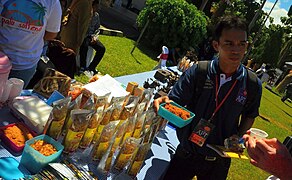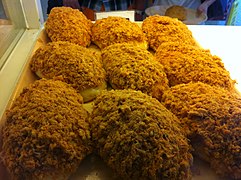Meat floss
Taiwan and Vietnam | |
| Main ingredients | Pork, beef, or chicken |
|---|---|
| Meat floss | |||||||
|---|---|---|---|---|---|---|---|
| Chinese name | |||||||
Hakka name | |||||||
| Chinese | 肉麩 | ||||||
| Literal meaning | meat powder; meat fabric | ||||||
| |||||||
| Vietnamese name | |||||||
| Vietnamese | ruốc (Northern Vietnamese) chà bông (Southern Vietnamese) | ||||||
| Thai name | |||||||
| Thai | หมูหย็อง | ||||||
| RTGS | mu yong | ||||||
| Malay name | |||||||
| Malay | serondeng | ||||||
| Indonesian name | |||||||
| Indonesian | abon | ||||||
| Filipino name | |||||||
| Tagalog | mahu or masang | ||||||
| Khmer name | |||||||
| Khmer | សាច់ជ្រូកផាត់ sach chruok phat | ||||||
Meat floss, also known as pork or yuk sung (Chinese: 肉鬆; pinyin: ròusōng; Jyutping: juk6 sung1 ; Mandarin Chinese: [ɻôʊsʊ́ŋ]), is a dried meat product with a light and fluffy texture similar to coarse cotton, originating from China.[1][2]
Culinary use
Meat floss is used as a decorative and flavorful topping for many foods, such as congee, tofu, rice and savory soy milk. It is also used as filling for various savory buns and pastries as well as a topping for baked goods filled with bean paste, for example, or as a snack food on its own. Meat floss is a popular food item in Chinese, Vietnamese (called ruốc in the North, and chà bông in the South), and Indonesian dining.[citation needed]
Production and styles
Meat floss is made by stewing finely cut
There are two styles of meat floss, which differ in whether oil is added during the last process of production. The Jiangsu style rousong is dry-cooked and the product is slightly chewy, while the Fujian style bak hu is fried with oil and the product is mildly crispy. Five kilograms (11 lb) of meat will usually yield about one kilogram (2 lb) of floss.[4]
Variations
| Part of a series on |
| Chinese cuisine |
|---|
 |
A very similar product is pork fu (肉脯; pinyin: ròufǔ; Pe̍h-ōe-jī: bah-hú), which is less fried and less shredded than meat floss, and has a more fibrous texture.
Fish can also be made into floss (魚鬆; yú sōng), though initial stewing is not required due to the low collagen and elastin content of fish meat. Rabbit and duck floss can also be found in China.[5][6]
In Japan, a variant made from fish is called dembu (Japanese: 田麩).
In Muslim-majority Indonesia and Malaysia, beef or chicken floss is the most popular variant, commonly called abon in Indonesian and serunding in Malay. In Malaysia, serunding is a popular delicacy during Ramadan and Eid al-Fitr.[7]
In the Muslim-majority Hausa cuisine of Northern Nigeria, dambu nama is a dry, shredded beef snack, similar to meat floss. It is fried and heavily spiced in its preparation.
-
Fish floss is roasted to look similar to yuk sung
-
Beef floss for sale in Sulawesi, Indonesia
-
Meat floss buns from Hong Kong
Health effects
A study has demonstrated a positive correlation between increased processing temperatures of meat floss and increased formation of heterocyclic aromatic amines (HAAs) within the meat. Up to seven different HAAs were found when meat floss was processed at 150 °C.[8] HAAs are believed to promote the development of some cancers.[9]
See also
References
- ^ ISBN 978-0-671-07211-7
- ISBN 978-0-12-384734-8.
- ^ Vickie Vaclavik, Elizabeth W. Christian. Essentials of Food Science. Springer, 2003, p. 169.
- ^ Melia, Ken (2017). Review of Meat Floss – Identifying opportunities for Australian Red Meat. North Sydney: Meat and Livestock Australia Limited
- ^ Zhou, Zhen (2017). "Research of new duck floss with spicy flavor" Food and Fermentation Technology: 120–125 – via Food Science and Technology Abstracts.
- ISBN 978-1-4613-5220-4.
- ^ Thestar.com. "Thestar.com." Mum’s meat floss legacy. Retrieved on 2008-09-19.
- – via Web of Science.
- PMID 12351140.



